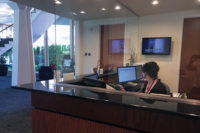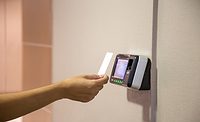At 110 stories, the Willis Tower (formerly known as the Sears Tower) is the tallest building in North America. As a major landmark and tourist attraction, the building draws 1.6 million people every year to see the view from the Skydeck. But there is another “side” to the tower: It serves as a workplace for 100 different corporate tenants ranging from United Airlines to law firms to the global insurance broker, Willis Group Holdings, which purchased the naming rights in 2009.
For these tenants, who use a different, highly secure entrance from the ones tourists use, the process of monitoring contractors, clients and other visitors to their suites can be a challenge.
“We have a closed building with turnstiles all the way around the elevator lobbies,” says Keith L. Kambic, CPP, senior director of security and life safety services for U.S. Equities Asset Management LLC, the property management company that manages and leases Willis Tower. “We probably have 2,000 visitors per day to the business side. When I first got here the visitor credentials they were issuing weren’t scheduled by the tenants themselves. Consequently we saw a certain volume where the front desk was processing people who said they were there to see XYZ company and sending them on their way. We had people going up into the building who weren’t really supposed to be there, often salespeople. If you are going to cold-call on someone, this looks like a great place to come.”
A User-friendly Solution
Just a few years post-9/11 when Kambic came to Willis Tower, one of the key goals was to make the building secure, yes, but also customer service oriented and friendly. “In order to stay competitive in the Class A high-rise market, we needed to reposition ourselves from that standpoint,” Kambic says. “One way that allowed us to do that was through a new visitor management system.”
Kambic came to Willis Tower from the Aon Center, another prominent Chicago skyscraper, the city’s third tallest. In his capacity at Aon, he had worked with a company called Veristream, Orlando, Fla., to develop a unique online visitor management system.
After looking around at other systems, Kambic came back to the visitor system as his ultimate choice for Willis Tower as well. “I knew how easy it was to implement with the general population, which was what I was looking for.”
Still, the new system would require the tenants to think differently about how they managed their visitors.
“It was a major change where the tenants went from registering no one to registering everyone,” Kambic says. “They needed something that is not difficult, that they can get the first time. I didn’t want any excuses not to use the system.”
From his previous experience with it, Kambic was confident that the system was a stable and easily adaptable platform.
At Willis Tower, Kambic decided to use that feature again, in addition to adding a new one: service kiosks in the lobbies, something that was not commonly available at the time.
“One of the most important things to us is throughput and making it a pleasant experience for the guest, because if you handle them right coming and going, those impressions will last,” Kambic says. “We looked at our visitor patterns and saw that employees who forget their building ID cards and regular visitors were making up a certain percentage of the overall traffic and congesting the line for other visitors into the building. We took the model that airlines use and adapted that to a state ID that ties into my access control system, so that once a regular user is enrolled in the system they can use the kiosk – eliminating that place in line and giving everyone a more pleasant experience.”
How it Works
The system is hosted, which means the company takes charge of the details like back-ups, updates and troubleshooting.
“I prefer that it is hosted by them,” Kambic says. “We have had very little downtime in the nine years we have used it. For us, one of the worst things would be to come in on a Monday morning, discover the system is down and then have to get someone here onsite to get it up and running.”
While Veristream hosts the system, Willis Tower still retains control and management of it, with the same person who does access control database management also managing the visitor management side.
The system is also integrated with Willis Tower’s access control system from Johnson Controls. “The two systems talk to each other, which is very nice,” Kambic says. “With this system, every visitor must have a ‘sponsor.’ Before the integration, those records sometimes became stagnant, so if I deleted a card on the access control system it didn’t necessarily delete that sponsor on the iVisitor side. In the past eight years we have made that backward and forward integration, which keeps those records clean.”
Each tenant can also put people on an internal “barred” list, which is checked each time someone registers as a visitor. “It will send an alarm letting us know there is an issue,” he explains.
The visitor management system is quick to use, both for the registering tenant and the visitor.
“From the tenant standpoint it only takes up to seven seconds,” Kambic says. “They put in the first and last name, enter the date and time of the visit, put any other relevant information in there and hit ‘done.’ If anything, it is two steps. It also has a nice ability to upload a spreadsheet in case they have 100 people coming at the same time, so they don’t have to individually enter each one.
“Because it is an online real-time system, as long as the tenant has registered their guest and we have that information at the front desk, our processing goal for the visitor is 27 seconds, and we have gotten it down to probably 23 seconds. Someone greets the customer, pulls up the record, scans the driver’s license, prints the ID and sends them on their way.”
The Web-based nature of the system allows the tenant to choose how they want to register their visitors. From assigning the responsibility to a single person per office, to allowing each employee to do it from their desktop or even mobile device, there are a variety of ways to use it.
Kambic is even considering ways to use smartphones and navigation technology to improve the visitor experience in the future.
“We have looked at using smartphones in a similar fashion to the way airports do,” he says. “It has the ability to send emails with bar codes and an officer could then use a pad to scan the ID and the bar code, eliminating both the need to print a badge and to visit the receptionist. We are also looking at tying that to a navigation system that could be sent to the visitor’s phone as well: a ‘you are here’ map that will tell them exactly how to get to their destination within the building. We are hoping to implement this in next year’s budget cycle.”
Seeing Results
Having used the system for close to a decade, Kambic has had the opportunity to see up close the results of implementing a tenant-led online system like the system, which processed 325,000 visitors to the corporate office side last year alone.
“Now the tenants have a much better handle on who should and shouldn’t be allowed to be there,” he says. “We have had instances where a salesman who was authorized by one tenant decided to start making calls on other parts of the building. Those tenants now call us and ask, ‘How did this guy get in here?’ They are more aware of the people in the building and who is coming into their space.”
Kambic has also realized benefits, himself. “I can use the data it produces for a lot of other stuff. When I get a report that shows me the majority of visitors come between 8:30 a.m. and 10:30 a.m. and 2:00 p.m. and 4:00 p.m., that translates to me knowing how to staff my desks and making sure I am spending my dollars correctly. I am not overspending when not a lot of people are coming in. The same thing is true with slips and falls, believe it or not. Using this same kind of data, I now know that I will have X number of visitors coming in during these time periods and maybe I need more housekeeping out there when it is raining to mop up the water and prevent accidents.”
Kambic also turns to the system as a useful tool come budget time. “It gives me validation for what I am asking for. Just in the last couple of years, as we have continued to rent more and more space, building occupancy has gone up. Studying that data told me I needed an additional receptionist, and I was able to make that case.”
But at the end of the day, the original purpose is still the most positive result by far, Kambic adds. “The biggest benefit is ease of use. It is human nature. If you have something that requires 500 steps and is very arduous to get something done, as opposed to a very easy task to enter and delete people, that sells the system right there.”
And it seems the tenants would agree. “Nine years of no complaints = ease of use,” Kambic says. “Silence is golden.”




